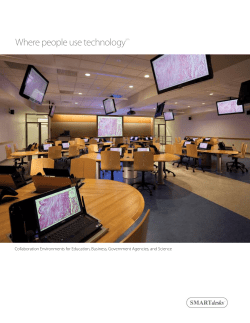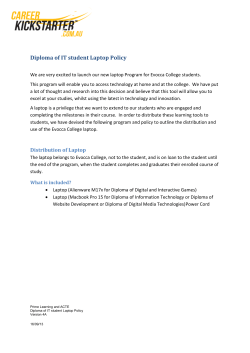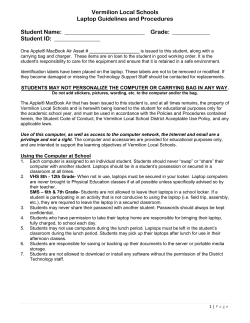
T
Yeh, K.-C., Gregory, J. P., & Ritter, F. E. (2010). One Laptop per Child: Polishing up the XO Laptop user experience. Ergonomics in Design, 18(3), 8-13. One Laptop per Child: POLISHING UP THE XO LAPTOP USER EXPERIENCE B Y K U O - C H U A N ( M A R T I N ) Y E H , J O N A H P. G R E G O RY, & F R A N K E . R I T T E R Children and HCI experts are finding it difficult to perform simple tasks on the XO laptop, posing a risk to its success. T Copyright 2010 by Human Factors and Ergonomics Society, Inc. All rights reserved. DOI: 10.1518/106480410X12793210871708 he “One Laptop per Child” (OLPC, wiki.laptop.org/ go/The_OLPC_Wiki) project helps children gain access to education by designing and distributing an inexpensive, connected children’s laptop. Initiated in January 2005 by Nicholas Negroponte, cofounder and director of the MIT Media Lab, the OLPC project has received widespread press coverage and praise for its commitment to improving children’s learning, especially for children in the developing world. Several industrial hardware leaders have joined the project and become sponsors. Government officials in many countries – including Argentina, Brazil, the United States, and Uruguay – have expressed great interest in the project. In this article we discuss the XO laptop – the low-cost children’s laptop that is at the center of OLPC – in terms of its usability. Our study suggests there is much room for improvement in the XO laptop user experience, particularly with regard to the unique needs of children. We offer practical design modifications to help create a better user experience for children without compromising the XO laptop’s low cost. This in turn may help to secure a brighter future for the OLPC project and provide lessons for similar projects. A Laptop Designed for Every Child The XO laptop combines many technology innovations and is often called the “$100 laptop” because of its target price. We will call it by its project logo name, the XO laptop, because its price may vary from its $100 target. The goals of the XO laptop’s hardware design were that it be affordable, rugged and resistant to moisture and dust for children to use in different environments, and low in power demand in locations where power outages are frequent. Usability was not prominent in these early goals. The first batch of XO laptops was released in December 2007 (one is shown in Figure 1) and received good reviews with regard to its innovative hardware design. However, the near- and long-term future of the XO laptop remains uncertain because of the lack of empirical field data and other potential social and cultural concerns (Perry, 2007). 8 E RGONOMICS IN D ESIGN • SUMMER 2010 The main author’s daughter working with the XO laptop. Why Usability Risk Matters In a recent report, Pew and Mavor (2007) presented a theory of how to address risk in large system designs (such as the XO laptop, its users, and their educational systems): Designers should more explicitly include usability risks in the spiral development model (Boehm & Hansen, 2001). Pew and Mavor argued that poor usability is a risk to the success of projects and that this risk must be both judged and compared with other risks (such as cost and manufacturability). Under the guidelines of this model, software design processes are divided into several phases whereby an understanding of risks is used to determine project development. In other words, risk management can be seen as a driver for the success of large systems. A recent report argues it applies to a range of systems (Stark & Kokini, 2010). We explored the usability of the XO laptop as a potential risk to the success of the OLPC project. If usability is not tested and managed, the success of the project might be affected, as has been the case with other new technology projects. In this case, the risk arises because children may interact with technology in ways that are different from how the adults who designed it envisioned (Bruckman & Bandlow, 2007), and potentially in ways that the designers could not predict. There is little published data describing children’s use of portable laptops, and the users of this product are rather different from its designers. When little is known, simple usability studies will help to reveal previously unseen risks (Clarke, 2006). The results of our study suggest that these target users appear not to have been the focus of the design decisions, and it provides ways the XO laptop can be improved (and the risks decreased) with several inexpensive interventions. Examining Procedures Because the XO laptop is designed for children, the primary data for this study were gathered by observing and interviewing schoolchildren as they used the laptop. We also included heuristic evaluations by HCI experts, because certain long-term issues, which are harder to identify without longitudinal studies, can potentially be predicted by HCI experts without awaiting these long-term research results. Collecting data from these two seemingly different groups – children and HCI experts – gave us a broader perspective and a wider range of data on possible problem areas of the XO laptop, particularly for its use in the United States. Three elementary schoolchildren and five HCI experts participated in our study. One child was in the third grade, one in fourth, and the other in the fifth grade. The HCI experts included four graduate students who have taken HCI graduatelevel courses in industrial engineering, information sciences, and communications, and one professor who teaches HCI and related graduate-level courses. The HCI experts used computers daily, and the children used computers at least twice a week. These results provide one perspective. However, we should caution readers that the experiences of our users may be different from those who have never used personal computers before. Both the HCI experts and the elementary schoolchildren were asked to perform the same set of three tasks on an XO laptop – create a document, paint a picture, and record a photo, video, or audio – in a series of three separate sessions, with one task per session. The XO laptop used was from the first release batch in December 2007 and did not contain any updates or modifications. Sessions were at least one day apart. These tasks were isolated from each other so there was no data exchange between activities. Each task examined the design of a specific activity and the general system navigation of the XO laptop. FEATURE AT A GLANCE: We examine the user experience of the XO laptop (the “$100 laptop”). The XO laptop combines many technology innovations and is used in the United States and abroad. We asked users to perform a range of simple tasks to demonstrate that several aspects of the XO laptop and similar devices can be improved, including hardware and software. Our recommendations are not difficult modifications. What we found suggests that usability problems may pose a greater risk to the success of this device than perhaps was imagined by its designers. We hope to see the XO laptop’s usability become more polished and that usability, in general, will be considered appropriately as a potential risk for similar products. KEYWORDS: usability studies, XO laptop, $100 laptop, risk-driven spiral model We analyzed the following general system navigation skills: opening and closing an activity; saving, retrieving, and deleting a document; and powering the laptop on and off. We also analyzed activity-specific skills, including typing using the keyboard, drawing using the touchpad, and using the built-in microphone and video camera. We told the participants that if they became uncomfortable or frustrated with a task, or could not otherwise complete it, they had the option of asking the experimenter for assistance to finish the session. After each session we interviewed the participants, focusing on their experience with the XO laptop. The intent of this postsession interview was to establish areas in which the participants believed the laptop could be improved, and to have each participants elaborate on his or her feelings in these areas. We encouraged the participants to give a retrospective opinion of the laptop, which we could then compare with the verbalizations participants made during the tasks and the problems they encountered or mistakes they made. The questions to the HCI experts were slightly different, because we assumed these experts would be able to deliver more focused opinions. TABLE 1. A DESCRIPTION OF THE TASKS GIVEN TO THE STUDY PARTICIPANTS, AND THE SKILLS REQUIRED Task Description Skill Required Create a document Use the Write Activity to create a table with three headings – state name, capital name, and population – to describe three different states. Information is provided in the instructions. Save and find the document after closing the Write Activity. This task requires mainly typing skills, for both letters and numbers. It also requires menu selection for creating a table, and minimal use of the touchpad when it is necessary to change the cursor location. Paint a picture Use the Paint Activity to draw an animal face including eyes, ears, and mouth. Use different colors for face, ears, and eyes. Save and find the drawing after closing the Paint Activity. This task requires mainly touchpad operations for drawing. It also includes selecting and applying colors to different areas. Record a video and play it back Use the Record Activity to record a one-minute video. Use the Save and Use playback function to play the recorded video. This task lets participants explore the multimedia functions of the XO laptop. SUMMER 2010 • E RGONOMICS IN D ESIGN 9 Some Roadblocks We asked both groups of participants to provide concurrent verbal reports while using the XO laptop. We observed that all the children were able to verbalize their actions and feelings without trouble. Using “talk-aloud” verbal protocol analysis and interview data, we were able to qualitatively identify problem areas that our participants experienced. Some problem areas are related to hardware design and others are related to software or interface design. The following is a list of problem area categories we derived from the transcribed data analysis (summarized in Table 2, page 12). Problems Related to Hardware Design Opening the XO laptop. The data indicated that opening the XO laptop for the first time is a difficult task. None of the participants could open it in less than one minute, and only three of eight could open it without help. The antennas on the laptop also serve as locks: Down is locked and up is unlocked. We observed several instances of participants flipping up the antennas (shown in Figure 1) and flipping them back down, locking the laptop again. As some participants mentioned in the interviews, opening the XO laptop is definitely not easy, although this is a “one-time struggle”– once you learn it, you know how to do it. By the second session, inability to open the laptop was almost nonexistent. This may mean that some type of temporary or renewable solution such as a sticker may be sufficient. Using the keyboard. All the HCI experts indicated that the keyboard (shown in Figure 1) is small for adults but may be acceptable for children’s smaller hands. All the children in the study expressed that they found the keyboard to be unusual. Power Button View Mode Keys Touchpad Area Figure 1. A picture of the XO laptop highlighting various parts of the machine. A ruler at the bottom provides scale. 10 E RGONOMICS IN D ESIGN • SUMMER 2010 cursor stops at the center of the screen and a menu shows up for reboot and power off (shown in Figure 1). Every participant thought this menu was “something like the desktop” or “wallpaper” and didn’t think of it as a button. This is another example of negative knowledge transfer from PCs or Macs, which generally do not use such large buttons. Participants initially searched for small icons, and six of the eight participants could not find the shutdown/reboot tool without help. Border menu. The major problem with the menu visible around the border of the screen (shown in Figure 2) was that it often appeared when the participants did not want it. When it appeared, it overlapped the button they wanted to click, such as the stop button. Their typical reaction to the unexpected appearance was to sigh, move the mouse cursor to the center of the screen, and wait for the menu to disappear. Figure 2. A screen shot showing the border menu that appears when the mouse cursor is moved to either corner. One child mentioned that he wished the keyboard had the same feel and touch as that on a PC. Although HCI experts were not certain if the keyboard design is suitable for children, none of our child participants liked it. We attribute this to negative knowledge transfer from PC or Mac use. In general, the HCI experts did not like the keyboard, stating that it was too small and had a “mushy” feel, often noting that it was probably designed for children. The near- and long-term future of the XO laptop remains uncertain because of the lack of empirical field data and other potential social and cultural concerns. Not all HCI experts disliked the keyboard, however; one participant with an industrial engineering background remarked that the soft keys would suit children’s fingers well and suggested that their softness may help prevent cumulative trauma disorders (CTDs). File system simplicity. An “activity” on the XO laptop is the equivalent of an application on other computers. When an XO laptop user “keeps” a file, this is the functional equivalent of saving the activity. However, when the user activates the “keep” function, there is no feedback from the action, and there are no options as to how or where the file is saved. The files are accessed from the “Journal,” a center for activity logs (shown in Figure 3), and the files are also searchable, but some HCI experts were concerned that the lack of filing ability would prove to be a disadvantage, especially if children used the same XO laptop for an extended period. One participant noted: I felt the need for folders, but I don’t think the children would. Or, they might, because if they’re going to use it for a period of two to three years, it’s difficult to keep track of how and what name you saved a file. We then asked: “If the Journal provided features such as a search-by date, would that be enough to manage files without a folder filing system?” The response was, “No, I don’t think so, because you might not remember the date anyhow.” Using the touchpad. One problem we noticed when participants used the touchpad (shown in Figure 1) is that they often unconsciously moved their fingers out of the touchpad area into the adjacent stylus area and wondered what was wrong when the cursor stopped moving. Because there are no tactile cues to distinguish the touchpad from the adjacent stylus, there is no way to tell these two areas apart without looking down from the screen. Problems Related to Software/Interface Design Shutdown/Reboot tool. Although powering on was easy for all our participants – as some of them noted, you “simply press the universal power button” – the proper powering-off process proved to be challenging for nearly half of them. The software power-off, shutdown, and reboot mechanism appears when the Figure 3. A screen shot illustrating a list of activities in the Journal document editor on the XO laptop. SUMMER 2010 • E RGONOMICS IN D ESIGN 11 TABLE 2. OBSERVED DIFFICULTIES FOR EACH POPULATION Area of Difficulty Children HCI Experts Opening the XO laptop ✓ ✓ Finding the shutdown button and turning off the XO laptop ✓ ✓ Finding saved activities ✓ ✓ Confirming that activities are saved ✓ ✓ Bringing up the border menu only when needed; the border menu popped up from time to time when the mouse cursor was accidentally moved to the corners. ✓ Keys are not very responsive. ✓ Keyboard feels “different” and small; most acknowledged it was designed for children. ✓ Staying within the touchpad area ✓ These responses and others led us to believe that the file system of the XO laptop may be confusing or not intuitive to users, and some type of extension or folder system may be more appropriate. Another study of the XO laptop also mentioned that the file system was among the top three things that the children disliked, even if they did not have prior PC or Mac experience (Hourcade, Beitler, Cormenzana, & Flores, 2008). Inconsistency of the feedback system. The feedback system in the XO laptop is either missing or inconsistent. For example, when a button is inactive, its appearance does not give users a visual status cue, such as being grayed out, to indicate its current status. We observed instances in which participants tried to insert a new row in a document by clicking on the “Insert a row” icon. Nothing happened when the mouse cursor was misplaced in the document, given that the cursor must be in the row where the new row will be added. Because nothing changed, participants were uncertain as to whether or not they had clicked it and, as a result, clicked several times. Eventually, they realized that it did not work in that particular situation. The risk arises because children interact with technology in ways that are different from how the adults who designed it envisioned. Another obvious discrepancy between the user’s expectation and the system’s feedback is the “Keep” function. Every activity has a “Keep” option under an “Activity” tab to store the current activity in the Journal for future retrieval. When “Keep” is clicked, there is nothing that visually indicates to the user whether or not the activity has been saved. One HCI expert remarked: “If an adult can’t figure out what it’s doing, I wonder if a child can. And I don’t think that has anything to do with our previous experience or anything.” This problem was compounded by the fact that when the mouse hovered over the icons, a tool menu would appear, as 12 E RGONOMICS IN D ESIGN • SUMMER 2010 with a PC or Mac. Most participants would then try to click the wording below the icon, which produced no result except for closing the menu. Although some drop-down menus support clicking on text options, such as the shutdown/ reboot menu, the text under “Keep” is partly active and partly inactive. That is, the user can select the text output type, but that does not save the activity. There is also a line that simply says “Keep”; if the user clicks that word, the menu closes and the activity is not saved. When this happened, we asked participants if their activity was saved, and the answer was universally “I don’t know.” We believe this result arises from the lack of feedback. The same issue was also present in the XO laptop’s boot process – lack of information as the machine started up had several participants wondering if they correctly turned on the machine. Findings and Recommendations The XO laptop is an exciting technology for encouraging exploration and collaboration among children. However, the interactions between our participants and the XO laptop have empirically demonstrated that many usability problems exist within the design of the hardware, software, and operating system interfaces for users who have PC or Mac experience. We summarize our experience with the XO laptop in Table 3 for instructors, teachers, and parents who want to adopt the XO laptop. We hope the information in this table will provide a shortcut to a more pleasant experience. The XO laptop lacks accompanying physical documentation. Further, the laptop itself does not have obvious help functionality included in the operating interface, so initial assistance is limited. The OLPC project does have a wiki available on the Internet for support and help, but this source of support may not be of sufficient help to all XO laptop users because the Internet is not always available in many locations, and users who need assistance with the XO laptop may not be able to access the Internet at all. The results of this and similar empirical studies can identify design issues of the XO laptop and serve as a source of information for a wiki and as an initial source of information for a physical operation manual if one is ever developed. TABLE 3. SUMMARY OF SUGGESTIONS FOR ADOPTING THE XO LAPTOP Potential Issue Recommendation Basic operation of the XO laptop Children should be taught about opening the laptop, powering it on/off, and using the view mode keys. XO laptop user interface Children should be taught how to navigate in the Sugar environment (the desktop environment of the XO laptop), especially to show/hide the border menu, and about the meaning of icons on the desktop. Touchpad Use a narrow sticker to differentiate the touchpad area from the stylus pad area. File and feedback system Children should learn a procedure to ensure their work is kept in the XO laptop without a problem. Although these design flaws hinder the usability of the XO laptop and create frustration when interacting with it, at least initially, many of the problems would be easy to fix through redesign and end user training without increasing the cost. These appear to be areas for improvement, not fatal flaws. Flores and Hourcade (2009) observed and described their positive experience with the XO laptop in Uruguay. They, too, noted ways to improve both the hardware and the software. Because several school districts in the United States have already purchased XO laptops, these usability issues could be an obstacle for information and communication technologies integration in those locations. These results, though not devastating, are not encouraging. This design does not appear to have included a consideration of the types of users, the tasks they would complete, or usability risks. A recent National Academies report on reducing usability-related risks in system design (Pew & Mavor, 2007) provided a framework for understanding this: In this project, usability was most certainly seen as a lower risk than hardware price. However, these results suggest that the risk of failure or decreased use caused by usability problems is greater than the designers had imagined. We hope the OLPC project and users can learn from this report and improve the usability of the XO laptop accordingly, and that similar manufacturers will see how small investments in usability can reduce risks to product success. Acknowledgments Comments from Noela Haughton and Yu-Chang Hsu helped improve this article. References Boehm, B., & Hansen, W. J. (2001). The spiral model as a tool for evolutionary acquisition. Crosstalk, 14(5), 4–11. Bruckman, A., & Bandlow, A. (2007). Human-computer interaction for kids. In A. Sears & J. A. Jacko (Eds.), The human-computer interaction handbook: Fundamentals, evolving technologies, and emerging applications (2nd ed., pp. 428–440). Mahwah, NJ: Erlbaum. Clarke, A. M. (2006). The reality of ICT use is failing to meet the user’s requirements. Interactions, 13(5), 26–29. Flores, P., & Hourcade, J. P. (2009). One year of experiences with XO laptops in Uruguay. Interactions, 16(4), 52–55. Hourcade, J. P., Beitler, D., Cormenzana, F., & Flores, P. (2008). Early OLPC experiences in a rural Uruguayan school. In CHI ‘08 Extended Abstracts on Human Factors in Computing Systems (pp. 2503–2512). New York: ACM Press. Perry, T. S. (2007). The laptop crusade. IEEE Spectrum, 44(4 April), 28–33. Pew, R. W., & Mavor, A. S. (Eds.). (2007). Human-system integration in the system development process: A new look. Washington, DC: National Academies Press. Stark, R. F., & Kokini, C. (2010). Reducing risk in system design through human-system interaction. Ergonomics in Design, 18(2), 18–22. Kuo-Chuan Yeh is an assistant professor in the Department of Computer Science and Engineering at the Pennsylvania State University. His research interests include software engineering, modeling human learning, and studying new technology in learning environments. He also enjoys developing computer programs and playing drums. He can be reached at kqy1@psu.edu. Jonah P. Gregory received his master’s degree in information sciences and technology at Penn State. His current research includes works in information hiding, MP3 steganography, computer and network security, and human-computer interaction. In addition to conducting research, Jonah also works as a system administrator and developer for the Journal for Research in Mathematics Education, and as a development testing automation engineer for Cisco Systems. He is an accomplished musician. Frank E. Ritter helped start the College of Information Sciences and Technology at Penn State. He is also affiliated with the Industrial Engineering, Psychology, and Computer Science Departments. He is interested in the cognitive modeling of users as a way to test interfaces. He is working on a textbook, The ABCs of HCI, with Baxter and Churchill. SUMMER 2010 • E RGONOMICS IN D ESIGN 13
© Copyright 2025





















